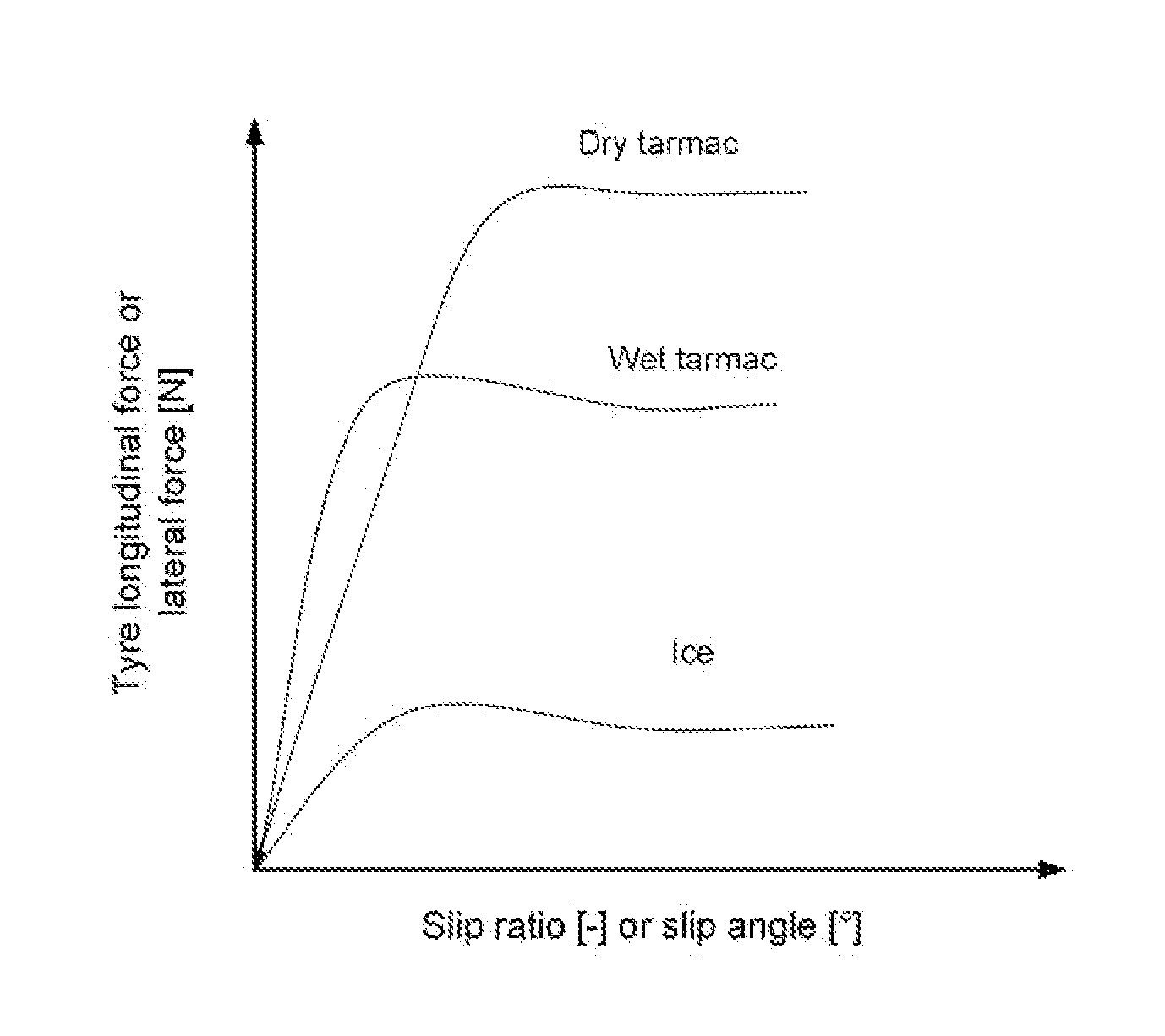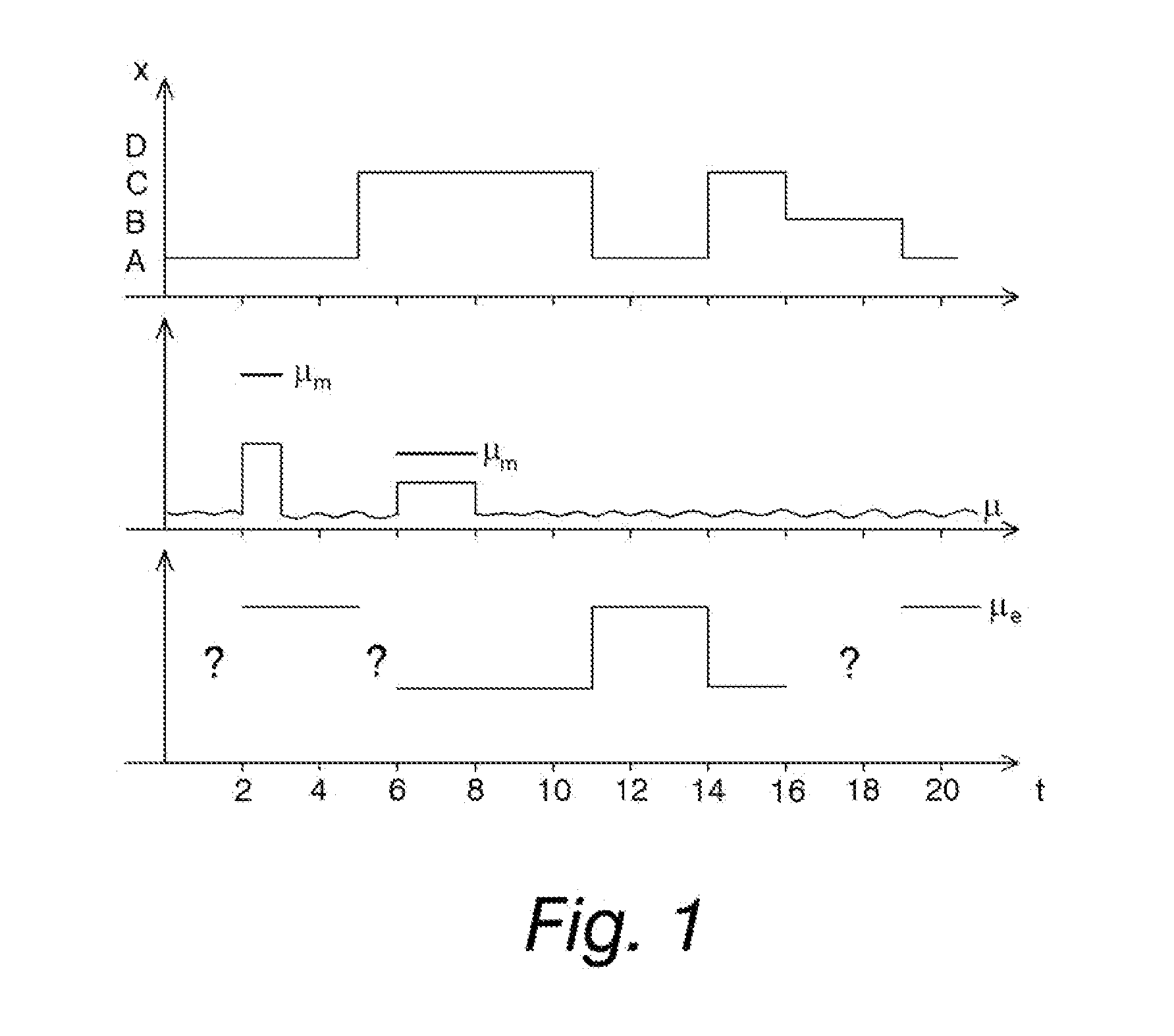[0023]An object of the invention is to provide a more accurate-than-before estimate for maximum friction for more of the time than before. Another object of the invention to provide a more reliable-than-before error estimation for the estimated maximum friction value. This enables improving the systems controlling a vehicle's driving dynamics and the driver can be cautioned about slippery conditions on the basis of information more precise than before. For example, on the basis of a mere sensor message, there will be unnecessarily frequent warnings in winter conditions about ice which is not more slippery than usual. The warnings perceived to be futile do not improve safety, but are just a nuisance to the driver. Thus, it is another objective to improve the reliability and legitimacy of warnings delivered to the driver.
[0027]Also the measurement results from driving dynamics can be used for classification, and the measurement results from driving dynamics can be stored in more detail than maximum friction alone, for example the slip and steering force values can be stored as function of side forces. Advantageously the
system recalls for example the value of the maximum friction and the corresponding slip for each classified measurement result. It is also possible to recall more accurate tyre force diagram and the measurement result of the tyre force diagram can be used to opposite direction for classification, in which case the accuracy of driving dynamics improves and the tyre force diagrams measured in small slip values that are not adequate for estimation of maximum friction as such can be used for assisting the classification together with the sensor data for recognition and classification of the road surface.
[0030]According to the invention, the driver can be cautioned as the friction properties of a tire seem to have changed for worse. The deterioration may result for example from incorrect tire pressures or damage to the tire, for example from oil or loosening of studs. The source of altered friction properties may also be a sensor defect, a change of tire without notifying the
system, wearing or faulting of shock absorbers or other parts of the
chassis. Thus, the
system works preferably as an aid to the driver and notices a change of driving feel also over a long period by comparing old and fresh measuring results with each other. Normally, the driver does not notice slowly changing driving characteristics, for example the deterioration of maximum friction caused by the wearing of a tire or wheel suspension. A method according to the invention enables tracking the friction properties of a tire as a function of time, since the system monitors not only the maximum friction but also the road surface measuring results and enables comparing to each other the results measured with a similar road surface in similar conditions.
[0031]The reading of a road surface measuring sensor can also have positional data integrated therewith and a telecommunication link enables the integration of data gathered by several vehicles, on the basis of which it is possible to classify road surface properties and to even make predictions about the grip of one's own tires based on measuring results of other road users. However, the measurements made by other vehicles have been conducted with different measuring devices and possibly with very different types of tires. By also integrating information about the tires of a measuring vehicle or by classifying the properties of tires and measuring-data transmitting vehicles in a centralized manner, it is possible to make more use of the measuring results of other vehicles as well. Required for this is a fair number of vehicles fitted with a system of the invention in order to provide each vehicle with measuring data appropriate therefor over one and the same stretch of road. The centralized estimation of maximum friction may also provide information about disparities of the maximum friction in the tires of vehicles moving in line. For example the icy smooth road creates a large difference between the typical studded tire and non-studded winter tire. This knowledge can be used for warning all the road users by roadside displays.
[0032]By means of the
exchange of information or the centralized estimation of maximum friction, it is possible to anticipate for various braking accelerations for example by making safety distances longer or by giving instructions to
restrict the accelerations of a line, such that the
hazard of a multiple
pile-up accident is diminished by reacting to a change of speed of the vehicle ahead more quickly and with lesser deceleration, whereby those driving on tires with less grip than the others have a possibility of maintaining safety distances as the line decelerates. Warning information can be supplied by short-range communication technologies or also to automobiles not provided with a system of the invention. It is also possible, at least technically, to use for example
signal lights or a
microwave transmitter to warn, for example, about the need of a longer safety distance because of a tire grip clearly worse than that of the others. In certain winter conditions, for example, the braking distances of heavy-duty traffic can be surprisingly much longer than those of other traffic, whereby
cutting inside the safety distance disturbs and endangers the traffic. Especially in intersections, it may beneficial to warn about a
low friction in order to refrain from trying to
cut into the safety distance that has been lengthened because of slippery conditions.
[0034]The driving stability and slippage control of vehicles offers its best utility in connection with heavy-duty combination vehicles as the skidding of a combination trailer and vehicle is not easily controlled by the driver when the skid has already begun. The combinations often have different tires on different axles, and as a result, there may be major variations in driving characteristics in various road conditions. The system according to the invention assists in anticipating and controlling the risk situations of such a combination better than before. The system according to the invention can be also be installed on a trailer, in which case the trailer-mounted system of the invention can independently calculate maximum friction estimates on the basis of measuring data given by the
tractor vehicle's or its own road sensors, or the trailer can be provided with just a memory unit or a
database for storage of measuring data to be used with the driving
control system of another
tractor vehicle in order to make the trailer's measuring data available for the system of the next
tractor vehicle. The system according to the invention is adaptable for any friction-driven vehicle, a passenger car or a motorcycle, and even a
pedestrian can be warned about slippery conditions provided that the road sensors and friction measurements can be arranged.
 Login to View More
Login to View More  Login to View More
Login to View More 


